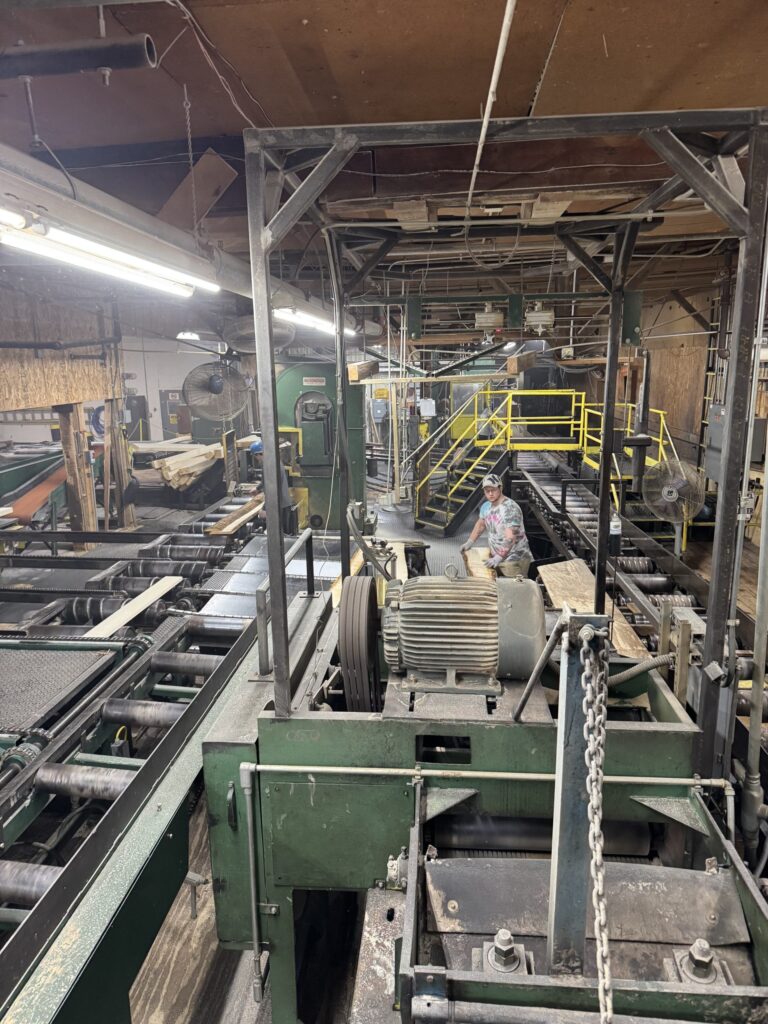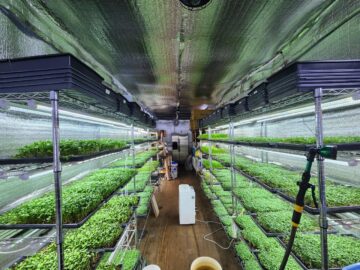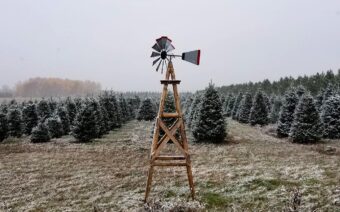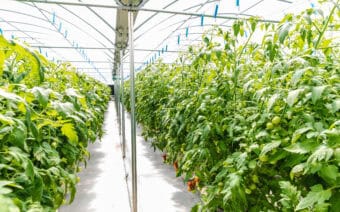
April 14, 2025
ANTIGO – When it comes to providing wood from the source, Company President Troy Brown said Kretz Lumber Co. has been growing, harvesting, manufacturing and delivering wood since 1929.
Brown said the global wood products company with a focus on American Hardwoods, located in Antigo, has always been in the business of sustainable, high-quality lumber for more than 95 years.
But as with many businesses of its size, he said it’s had to evolve to remain relevant.
For Kretz Lumber Co., Brown said that has included establishing a stronger focus on timber management of private lands about 15 years ago.
“We took a good hard look at ourselves and said, ‘What do we do best?’” he said. “The two things were timber management for private landowners and sawing, drying and selling random-length hardwood lumber.”
Good forestry is good for business, the environment
Brown said private landowner timber management now comprises about one-third of the business, with Kretz Lumber Co. focusing on about a 100-mile radius of its operation.
That’s a matter of practicality, he said, because transporting logs farther than 100 miles becomes costly.
Currently, Brown said the Kretz Lumber timber management team includes seven foresters who manage private timberland throughout the region – four in Wisconsin and three in the Upper Peninsula of Michigan – working with landowners who value forest health.
“Forestry really is a good science and, when managed properly, you’re perpetuating quality and minimizing the health risks in a forest,” he said. “We primarily have hardwood forests in this region, and we manage more than 200 private woodlots a year, ranging from 10-acre parcels to 240-acre parcels – working with landowners with a variety of objectives.”
Brown said one of those objectives follows a trend toward maintaining forests for recreational landowners who enjoy deer hunting, for example, and that effort can be performed alongside improving the quality of the forest land.
“Proper forestry does go hand in hand with recreational use,” he said.
Other landowners, Brown said, simply want a healthy wood they can enjoy perpetually.
For those whose forests require cutting as part of land management, Brown said foresters provide expert guidance on timber harvesting, followed by the landowner being paid for the wood that typically makes its way to established markets, including the paper industry.
“We make sure the product is used, including marketing the pulp wood,” he said. “The paper industry is one, but the veneer industry is another, as they make many different products, including sheet plywood. There are so many markets for that.”
Brown said one constant in the equation is for foresters to diversify the markets to benefit the landowners and simultaneously manage the timberland with a focus on sustainable forestry practices.
“Good logging begins with good people, and our harvesting team has more than 85 years of forest stewardship and logging experience,” he said. “We’re trusted to promote and practice sustainable forest management while meeting our customers’ lumber and land management goals.”

Though the science of forestry has been in practice since about 1930, and has practiced sustainability with intention for nearly 100 years, Brown said he recognizes there is still a stigma to forestry management for some people.
However, he said he emphasizes that landowners and communities would not have the healthy hardwood forests they have today if it weren’t for a cutover period that prompted a young, healthy hardwood to grow.
“These practices give us the beauty we have today when we drive between Wausau and Antigo and Eagle River and the UP,” Brown said. “We want this to last for generations and recognize the health benefits of young, healthy forests absorbing carbon out of the air. And to have that social benefit, we need to manage a forest sustainably, including cutting timber in order to keep it healthy.”
Brown said he sincerely believes the industry – and he’s been in it a while, having worked at Kretz Lumber Co. since 1986 – takes actions that are nothing short of magical.
“When it comes to our business, there is something magical that happens in a rural community, working in a rural-based industry, that I can’t really verbalize other than to say, it’s precious and it makes a person want to come to work every day,” he said.
Sustainability extends to business operations
Brown said sustainability of the business itself is also top of mind, given the hardwood industry is considered to be in recession and has become a decorative industry.
He said he attributes this to the volume of things in everyday life that are made of imitation wood products.
“I have many conversations with people who ask why the industry is in a recession, and I tell people to look around their home and tell me how many things there have a wood grain but aren’t wood – that’s why,” he said.
Currently, Brown said lumber comprises about two-thirds of the business, with Kretz Lumbers’ customers manufacturing finished products from their wood that go into homes.
The cabinetry industry, he said, is the primary user, but the flooring industry is not far behind – especially with the amount of sports flooring (made of maple) work completed in the region.
Serving the cabinetry industry, Brown said, has had its ups and downs.
“At one point, cabinet manufacturers couldn’t keep up with the demand for solid wood cabinets, and we saw an opportunity to provide them with the components that go into cabinets,” he said. “At one time, we had 60 people in the plant at one time for the cabinetry industry.”
Then, Brown said, the housing market was impacted by the 2008 recession and cabinet sales dropped – both as a result of that and homeowners embracing trends toward painted cabinetry.
The good news, he said, is that the tide is turning and there is a return to more wood-grain cabinetry, something he appreciates both from business and personal perspectives.
“HGTV came on and put on these painted cabinets, but there is now a trend back to wood grain and wood cabinets again,” he said. “More people are now saying, ‘I want the wood.’”
Brown said he has also observed that as society becomes increasingly health conscious, there is a movement toward wood because of its health benefits.
Among other things, he said incorporating wood products into the home is purported to create better emotional health, including reduced stress, lower blood pressure and improved air quality because wood moderates humidity.
“It’s a trend that is starting to build some momentum, and there are journal studies done on it and something we’ve been touting,” he said.
Brown said exported lumber is often used for furniture manufacturing that used to reside within the United States but has increasingly moved overseas and transformed Kretz Lumber into a global company in the process.
“The majority of furniture manufacturing has moved to China, and when that happened, we had to figure out how to ship lumber halfway around the world,” he said. “That happened pretty abruptly between 2005-10 after the ‘heyday’ of furniture manufacturing in the late 1990s in the United States.”
Brown said the shift shook up the timber industry.
“The hardwood industry produced the highest volume it ever had, and within a 10-year period, more than half the furniture manufacturing in the U.S. moved to Asia,” Brown said.
Today, Brown said about 25% of Kretz Lumber Co.’s product goes overseas – with the remaining 75% being domestic.
How business took root
Brown said it’s been quite a journey since Kretz Lumber Co.’s inception in 1929 to present day.
When Joseph and Myrtle Kretz realized the value of the hemlock bark from the trees on their farm, Brown said they chose to strip the bark off the hemlock for use at the local tannery – leaving the hemlock logs.
It was then, he said, that the Kretz family invested in a $75 portable sawmill generated by diesel power.

Brown said the move was fortuitous as it also benefited the farmstead directly.
“They used the wood to repair their dairy barn – the very dairy barn we built around as Kretz Lumber has grown,” he said. “The sawmill has equipment in it that runs in that old barn to this day.”
In the process, the family discovered they enjoyed the industry – having what Brown said he calls “sawdust in your veins.”
He said the Kretz family continued operating the sawmill, with local farmers bringing their logs to them to be sawn into lumber for their own use.
With growth and success, Brown said the family built a permanent sawmill for the farm and their three sons – Charles, Leon and Raymond – took on the business in the 1960s, running it until Dan (Joseph and Myrtle’s grandson) took the reins of the operation in 1973 and ran the business until 2006.
And it was during Dan’s tenure, Brown said, that the business made a significant shift in operations.
“(Dan) had learned that ERISA (the Employee Retirement Income Security Act of 1974) allowed for employee ownerships and knew right away that was going to be his exit strategy,” he said. “He built up the company and sold the company to the employees on a cold December night in 2000. I was sitting left of him when he was executing the documents and people said, ‘Dan, you have to pick a successor,’ and he said, ‘I guess you’re it.’”
Brown said the Kretz Lumber Co. team that falls under his oversight typically numbers 83-85 people, with some fluctuation seasonally.
He said he believes being an employee-owned company has contributed to talent retention, as well as plays an important role in talent acquisition.
“It’s tough because the (City) of Antigo is only 8,000 people, and there are some very good companies here,” he said. “We have always been competitive with our wages and benefits, but our employment has been very stable the past eight months.”
Employee ownership makes the difference
Brown said the employee stock ownership program (ESOP) culture has also had a significant role in the business’s well-being and longevity.
“I know for sure we would not have survived the 2008 recession without it, without everyone (as employee-owners) paying attention to every little detail and understanding an injury could be devastating,” he said. “We have a very low experience with our safety record and even the insurance company asks how we do it. It’s the ESOP culture and paying attention to details, including being safe.”
Brown said the culture also ensures that he doesn’t have to be concerned about a truck being overloaded or underloaded, or that the right packaging is applied to a truck, or that the accounting is being performed properly and in accordance with reporting requirements.
“The ESOP culture has been established and people do the right things because of the culture that comes with employee ownership,” he said. “If we can keep an employee here for five years, they’re lifers.”
Having the right people, Brown said, is important to Kretz Lumber Co.’s focus on being service-oriented; having the right people selling their products is crucial to operations as well as they have to be very knowledgeable and relationship-oriented.
He said customers do repeat business with Kretz Lumber Co. for several reasons, including service, expertise and consistent quality.
“We deliver the exact quality customers are looking for, delivered exactly when they want it,” he said. “We have one customer who wants delivery exactly at 7 a.m., and we make sure to know what the weather will be and truck it ourselves so that it arrives precisely at 7 a.m.”
Brown said it is unique for the company to have its own small, in-house truck service, but said Kretz Lumber Co. has long-term relationships within the transportation industry to ensure reliable delivery.
“Even when people couldn’t get a truck a few years ago, we didn’t have that problem because we’ve been working with these transportation companies as long as we have,” he said.
 Farm Doc Microgreens: Where less is more when it comes to nutrition
Farm Doc Microgreens: Where less is more when it comes to nutrition Honoring family history, while embracing the future
Honoring family history, while embracing the future






